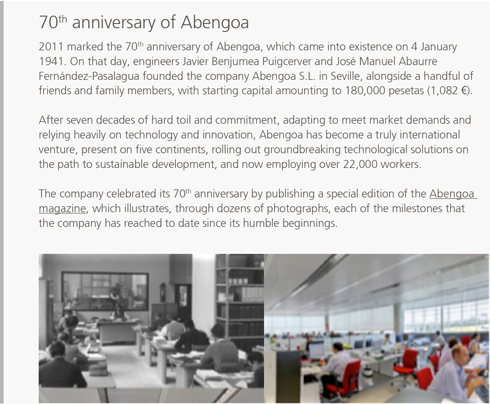 Abengoa
Abengoa
Annual Report 2011
- Corporate Social Responsibility
- Profile of Abengoa
- 2011 milestones
- Solana, located 70 km southwest of Phoenix, Arizona, is one of the world’s largest thermal solar plants under construction, and will boast 280 MW of gross installed capacity (250 MW net) through cutting-edge parabolic-trough technology. Solana will generate enough energy to supply 70,000 US households, while cutting yearly CO2 emissions by 475,000 tons.
Solana will include six hours of storage through molten salt technology, enabling it to store energy during cloudy spells and after sunset. This storage capacity will allow Solana to generate enough electricity to meet peak evening demand during the Arizona summertime.

The construction and operation of Solana will bring with it huge economic and environmental benefits for the State of Arizona, and will help to accomplish the national energy independency objectives established by the “green economy”. Abengoa is confident that the project will generate between 1,600 and 1,700 new temporary jobs during the construction phase, and 85 permanent positions once completed.
- Mojave, one of the largest concentrating solar power plants currently under construction, is located 150 km northeast of Los Angeles, California. The facility has an installed capacity of 280 MW of cutting-edge parabolic-trough technology, enough to supply power to over 54,000 households1, while curbing annual CO2 emissions by 350,000 t when compared with a natural gas plant.
Mojave will create over 900 jobs during the construction and operation phase, and roughly one thousand direct and indirect jobs along the supply chain extending across the nation, involving the manufacture of components and rendering of the services required for a project of this magnitude.
The project will provide a major economic boost to the region and will help the State of California replace fossil fuels for solar power and other alternative sources that do not involve greenhouse gas emissions.
- Hugoton, one of the first commercial plants to produce second generation ethanol from biomass, the most abundant organic raw material on Earth (mix of agriculture waste, non-food energy crops and wood waste). The plant is located west of Hugoton in Kansas, and will have a production capacity of 25 Mgal (100 ML).
Hugoton will lead to the creation of 300 new jobs over the construction phase and a further 65 jobs once operational.
Construction of the plant is the result of the R&D work conducted by Abengoa, which has been working for over ten years on developing enzymatic hydrolysis and for five years on this specific project, perfecting its proprietary technology at the York demonstration plant in Nebraska, and in Babilafuente, Salamanca (Spain).

1.The difference in households supplied via Solana is due to the fact that Mojave has no storage capacity..

© 2011 Abengoa. All rights reserved
